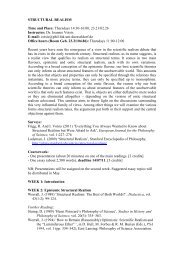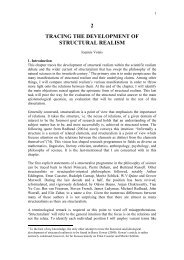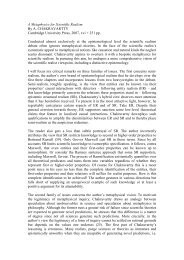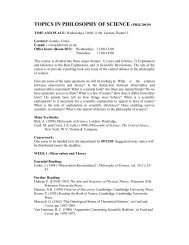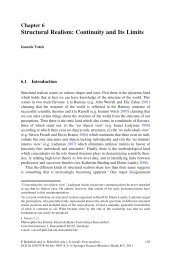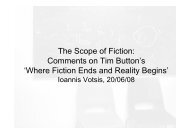Review of Kyle Stanford's Exceeding Our Grasp - Ioannis Votsis
Review of Kyle Stanford's Exceeding Our Grasp - Ioannis Votsis
Review of Kyle Stanford's Exceeding Our Grasp - Ioannis Votsis
You also want an ePaper? Increase the reach of your titles
YUMPU automatically turns print PDFs into web optimized ePapers that Google loves.
The only potentially impressive predictive accomplishments in Stanford’s discussion <strong>of</strong><br />
the three theories <strong>of</strong> generation and inheritance boil down to Weismann’s prediction <strong>of</strong><br />
reduction division, something he brands “a previously unknown phenomenon in the<br />
history <strong>of</strong> biology” (p.130). The prediction, i.e. germ cells receive half <strong>of</strong> the germinal<br />
material <strong>of</strong> the parent cell, fails to impress when compared to the staple <strong>of</strong> novel<br />
predictions one finds in physics, where theoretically calculated values approach the<br />
observed values to many decimal places. Moreover, the phenomenon was neither<br />
previously unknown, nor clearly unexpected. As Stanford notes earlier in that chapter,<br />
Edouard van Beneden had already identified “‘maturation division’ (later termed<br />
‘reduction division’ by Weismann)” (p.106). He also notes that Weismann “became<br />
aware <strong>of</strong> van Beneden’s work and realised that… reduction division… fit his own<br />
theoretical predictions” (pp.106-7). Stanford <strong>of</strong>fers no independent confirmation that this<br />
was indeed the order <strong>of</strong> events, simply taking Weismann’s word for it. But let us not be<br />
unduly uncharitable. Perhaps, the phenomenon was unexpected but a welcome<br />
consequence <strong>of</strong> Weismann’s theory. Since Stanford uses this example to argue against<br />
the realists’ reliance on novel predictions (p.130, p.181, p.207), one anticipates an<br />
elaboration <strong>of</strong> the story behind Weismann’s prediction that answers the typical realist<br />
concerns on such matters, e.g. whether reduction division was a consequence <strong>of</strong> only<br />
some features <strong>of</strong> Weismann’s theory, whether these features survived into our modern<br />
account, etc. Instead, all we are told is that Weismann made this prediction “on the basis<br />
<strong>of</strong> purely theoretical considerations” (p. 136, f7).<br />
The three historical case studies prop up PUA, but only because its demands on genuine<br />
rivals are so meagre. PUA’s sole requirement is that rivals are roughly equally wellconfirmed<br />
by the available evidence. In a footnote, Stanford lowers the demands even<br />
further saying that strictly speaking alternatives should not be “effectively ruled out by<br />
the [available] evidence” (p.26, f10) [original emphasis]. He goes on to say that the<br />
stronger requirement, namely “roughly equally well-confirmed by the available<br />
evidence”, though not necessary is defensible and “deflects any suggestion that such<br />
alternatives were ignored on evidential grounds” (ibid.). Both requirements are simply<br />
too weak. Theories or theory parts can count as genuine rivals even if there is no evidence<br />
available whatsoever. Indeed, that’s precisely what Stanford has in mind with the<br />
aforementioned theories, for he prides himself that (at least with respect to the<br />
unconceived parts) “there simply was no available evidence” (p.134). Equally shocking is<br />
his use <strong>of</strong> this lack <strong>of</strong> evidence to thwart any objections about how easy it is “to judge<br />
that a given alternative was even roughly as well confirmed” (ibid.). But to suggest that<br />
lack <strong>of</strong> evidence can convey (a) what counts as a genuine rival and (b) what counts as<br />
more or less roughly well confirmed is to reduce PUA to a lame duck. Or, to borrow one<br />
<strong>of</strong> Stanford’s expressions, PUA becomes ‘a pyrrhic victory’ for the anti-realist.<br />
Chapters six and seven are by far the most philosophically rewarding. There Stanford<br />
undertakes to defeat various realist replies to PI, for he takes some <strong>of</strong> them to also<br />
threaten PUA (p.141). Quite a few <strong>of</strong> the objections he raises are not original, e.g. the<br />
deficiencies <strong>of</strong> pure descriptivist and <strong>of</strong> pure causal theories <strong>of</strong> reference, but they are<br />
rendered in an incisive manner. The most sophisticated recent defence <strong>of</strong> realism,



